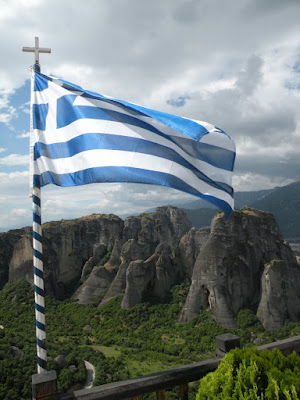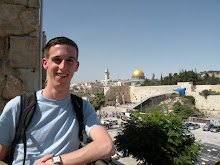On Friday we returned from a spectacular three-day trip to southern Israel. On Wednesday, we traveled through Judah, Philistia, and the Shephelah (the foothills). Thursday included the Negev region, and on Friday we traveled to sites on the Dead Sea. We're leaving this morning (Monday) for the north (Galilee) and won't return until Thursday night. No internet again. But here's a post summarizing the past week down south and a couple of pictures from our weekend in Jerusalem. I'm having an absolutely INCREDIBLE time! Being away from Jerusalem for a few days last week made me realize how much I love living here. I'll miss it.
WEDNESDAY
Hiking through the area of Sataf, a former Palestinian village. Here we saw "house-caves" made out of cenomanian limestone.

The Valley of Elah, where the battle between Judah (David) and the Philistines (Goliath) occurred.

The infamous "foundations map" that we use to mark the contours of the land wherever we go!

Standing in what some call the oldest arched city gate in the world in Ashkelon (the bottom part of the sides is the original - you can see the difference in material easily). The city thrived during the Middle Bronze Age, from 2000-1550. It is right on the coast of the Mediterranean.

The beautiful Mediterranean Sea at Ashkelon - we had about an hour at the end of the day to swim!
THURSDAY
Ellen and me in our hard hats at the Iron Age (i.e. around rule of Saul, David, and Solomon) town of Beer sheva. You might recognize the name Beer sheva from the phrase "from Dan to Beer sheva." Beer sheva is one of the southernmost cities of the Biblical land, and Dan is one of the northernmost cities. We wore hard hats because we went through the massive underground cistern system that the town used...we hardly needed the hard hats! But it was so fun. :-)

Standing in the Holy of Holies at the ruins of the temple in Arad

We got the chance to hike through a beautiful national park called En Avedat. We climbed through the valley behind me, then hiked up the side of the canyon on the right. We ended up at the top - the bus met us there. :-) We sweated A LOT, but as Dr. Wright says, "Jesus sweated under this sun and in this land, too!" Can't argue with that!

Roman-style arch at Avdat

Israeli and National Parks flags

We ended our day on Thursday with a visit to the largest erosion crater on the globe, Macktesh Ramon!

Standing on the edge of the Macktesh Ramon crater
FRIDAY
Masada was fortified by Herod the Great as another one of his palaces during his reign. In 66 BC, Jewish zealots rebelled against Roman Rule, and Romans sought to silence the revolt. Thus started the infamous war that eventually led to the fall of Jerusalem and Israel. Masada was the last place to fall to the Romans in 73 AD and has since become a national symbol for the strength of Israel: "Masada will never fall again," goes the mantra.
The picture above is of Herod's Masada fortress from the west, looking out with the Dead Sea in the background.

On top of Masada, looking out onto the Dead Sea. The famous story goes that while the Romans were placing a siege on the remaining 900 rebels at Masada, the rebels killed themselves to defend their honor in lieu of being captured and enslaved. Hence the place has become this national symbol for honor. The story, however, is not supported by various historical evidence. First, Josephus, a first century historian, is where we get this story. Josephus wasn't even at Masada, but he claims to have heard the story from a few "cowardly women and children" who didn't kill themselves and survived. Secondly, suicide is not a noble way to die for the Jews - in fact, it is against Torah. Suicide is a noble way to die for the
Romans. Could it be that Josephus, who was writing to a Roman audience about the land of the Israelites, told the story in such a way that would have an impact on Roman citizens? I guess we'll never know. But we do know that 900 people died at this site, and it is an incredible place of mystery and power.

Again at Masada. You can see the Roman columns with their fluting and the frescoes on the wall. These styles were "imported" by Herod from the Roman empire.

Some friends on top of Masada. (left to right: Jacquie, Claire, me, Daniel)

With a 38% salt content, you can actually float in the Dead Sea -- it was amazing! The Dead Sea is the lowest place on earth, and it is 1200 feet deep. Because it is so salty, it dehydrates you very easily, so you can't stay in the water for too long. Ancient empires (most notably Egypt) traveled to the Dead Sea to harvest salt and tar.

The waterfall of Ein-gedi, the spring where David hid from Saul in 1 Samuel 23:29. En-gedi is right on the coast of the Dead Sea. Having come directly from tasting and experiencing the salty, dehydrating water of the Dead Sea, I pondered the significance of the location of this fresh spring of living water and a place of protection for David. In fact, we also learned that as the Dead Sea is drying up, they are finding many freshwater springs on the floor of and close to the sea. For me, this speaks to the imminence of Christ - fresh water in the midst of a salty sea, what some have called a poison sea.

Me in front of the waterfall at Ein gedi

Being refreshed by the fresh water (
living water) at Ein gedi. It felt SO good to swim in and drink of the pure water after being covered in the almost overwhelming salt of the Dead Sea.

This is the main entrance to Cave #4 at Qumran, where the Dead Sea Scrolls were found. It was so neat to be at the place where such historic documents were found!
SATURDAY - Back in Jerusalem

This is the Garden Tomb, the place some believe to be the site of the tomb of Joseph of Arimathea, where Jesus was buried. Archaeological evidence suggests otherwise, but it was an interesting place to visit, since it is really a 1st century tomb and looks much like the tomb in which Jesus was most likely buried.

Our tour guide was great - he reminded us that it doesn't even matter where the tomb is exactly. The important thing is that the tomb is empty, for He is risen! Praise be to our Redeemer, our Rock and our Salvation.
SUNDAY
On Sunday morning, we got up at 4 am and went to the Mount of Olives to watch the sunrise over Jerusalem. It was so beautiful! In the foreground are graves (discussed in a previous post), then you descend into the Kidron Valley before rising again to Dome of the Rock and the rest of the city. As we watched the sunrise, I listened to the Shema (Deuteronomy 6:4-9) being sung on my Ipod and read Psalm 48.
Sunday afternoon we had a test over the trip, then class, dinner, a worship service, and a reception at our professor's apartment.
FATHER SAMUEL
Father Samuel and his incredible beard! (The story was told in a previous post - we went to visit Father Samuel, a priest, at the Church of the Holy Sepulchre last Saturday night).
I'm really looking forward to Galilee - we leave in twenty minutes, so I have to go!
Peace of Christ.



















































